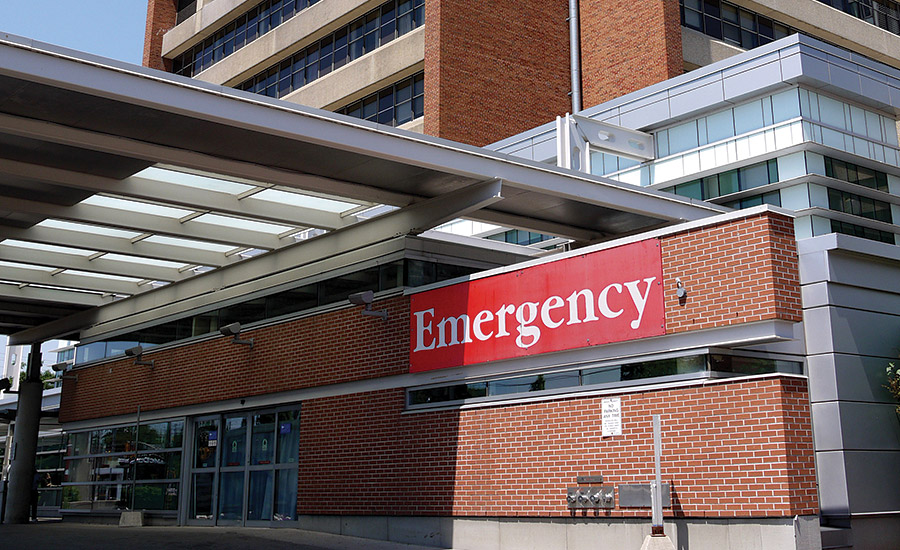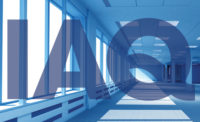Ultraviolet C (UV-C) technology has been used since the 1990s to eliminate microbial buildup on cooling coils, air filters, duct surfaces, and drain pans. But despite the technology’s history and track record, some facility engineers remain uncertain. On the other hand, some come around quickly.
That’s what happened at a 359-bed health care facility in Kentucky. Engineers struggled to keep the hospital’s cafeteria cool amid the area’s humid climate. Condensate in the air handling unit (AHU) serving the food service area was leaving a residue in the coil, a buildup that reduced airflow through the unit from the 14,000 cfm design parameter to around 10,000 cfm — nearly 30% less than what was originally specified.
“The air handler wasn’t able to help keep the café and kitchen cool during peak demand, especially during standard meal times in July and August, when occupancy and thermal loads were at their highest,” recalls the hospital’s director of engineering.
In an attempt to boost cooling capacity, the hospital’s maintenance staff tried to increase the volume of airflow over the coil by performing up to three mechanical coil cleanings per year at roughly $300 per treatment. According to the engineer, the cafeteria AHU was the worst performer among the medical center’s roughly 30 air handlers, and he was considering replacing it — a task that would cost more than $20,000 and require a two- to three-day unit shut down.
It was decided to put that plan on hold after speaking with Sales Engineer Charles Haskins with Thermal Equipment Sales based in Louisville, KY.
While at a meeting of the Kentucky Society of Healthcare Engineers, Haskins made the hospital’s director of engineering an offer he couldn’t refuse; allow for the installation of UV-C lamps in the cafeteria air handler and if performance didn’t improve in six weeks, the hospital wouldn’t pay a penny.
“Although UV-C has been used extensively in health care and institutional applications successfully for more than three decades, many facility managers remain skeptical,” says UVR Vice President Dean Saputa. “As air conditioning equipment ages, its ability to maintain adequate space temperatures and humidity levels decline. Most often, the culprit is reduced coil heat-transfer effectiveness, or the ability of an AHU’s cooling coils to remove heat from the air. UV-C systems remove organic growth on the outer and inner surfaces of the coil, thereby restoring the coil’s heat transfer efficiency to ‘as-built’ specifications.”
Saputa and Haskins were certain that they could restore the cafeteria’s airflow levels and meet the desired temperature set point simply by installing the UV Resources RLM Xtreme™ system.
In the end, an independent project audit vindicated the duo’s claim documenting a 35% increase in airflow, or an additional 3,700 cfm, as well as the ability to achieve the hospital’s cooling set points in the cafeteria.
According to UVR officials, the RLM Xtreme is a high-output fixtureless system that can be configured into most any HVAC plenum. The configuration installed in the hospital cafeteria’s AHU consisted of four T5, 61-in long UV-C lamps, a LampHolder that allows the lamp to be affixed in any position inside the air handler, and a power supply with a powder-coated, heavy-gauge galvanized steel and NEMA-2 rated housing. Its EncapsuLamp™ technology protects the system and airstream from glass and mercury residues should an accidental lamp break occur.
The UV lamps were installed on the downstream, air-exiting side of the coil, where they are most productive killing mold and bacteria and degrading all other organic materials. The UV-C wavelength removes this organic growth quickly, often in less than one month — a process that doesn’t produce any residual matter. The destroyed organic material is removed through normal condensate production until the coil is completely clean.
Officials said a properly sized and installed set of lamps will noticeably clean a coil in about 30 days with continued improvements up to one year later on severely clogged coils. The UV-C fixtures can be installed in about two hours at an installed cost of roughly $0.15 or less per cfm of airflow capacity. For the Kentucky medical center, the UV-C installation represented about 10% of the cost of a new, replacement coil.
Installation of the RLM Xtreme fixtures was completed in September 2014. The hospital cafeteria’s AHU was cleaned a few weeks before the installation, but continued to perform poorly.
“Outside temperatures were about 90˚F,” recalls Haskins before the UV-C lamps were installed. “The AHU was unable to meet the food center’s thermostat set points. The fan was running as fast as it could, but the unit couldn’t get temperatures below 84˚F in the kitchen or 78˚F in the café.”
Once the UV-C fixtures were installed, the team planned to evaluate progress following a three-month trial. To document progress, the cafeteria AHU was connected to a Super Scientifics manometer to measure pressure drop across the coil, and an Ebtron air monitoring station to record airflow levels. Both devices were equipped with data loggers.
The data was analyzed in mid-December. By that time, the September baseline measured airflow of 10,300 cfm had risen 35% to 14,192 cfm, which enabled the AHU to now maintain the desired set point temperature. The initial measured pressure drop across the coil of 2.66 in w.g. decreased to .69 in w.g., which meant that the fan amperage was obviously lower while achieving and maintaining desired temperature.
“The higher pressure drop across a dirty coil means the fan would have to work harder to compensate for the higher pressure drop and the coil’s diminished cooling capacity,” says Saputa, who notes that the increase in airflow volume and pressure drop reduction are not related to the cooler fall temperatures. “Once the coil has been cleaned, the fan doesn’t have to work as hard or draw as much energy.”
The facility engineer was impressed with the results.
“After a mere 90 days, airflow is back to design specs and we are able to maintain the desired temperature set points in the kitchen and cafeteria,” he says. “The AHU motor is drawing less amps, saving the hospital energy. Based on this successful demonstration, we’ve decided to incorporate these performance-enhancing UV-C fixtures in more of the hospital’s AHUs.” ES



